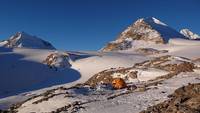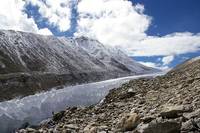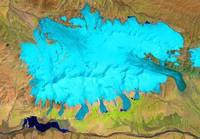News
16.01.2014
Glacial meltwater floods Tibetan pastures
Tübingen geographers probe glacier shrinkage and its effects
The earth is warming and glaciers are shrinking. However, not all the resulting meltwater causes sea levels to rise. Researchers from Tübingen University, the University of Zurich, and TU Dresden have shown that in Tibet, a significant proportion of the meltwater remains on land. But that is not necessarily a good thing – it can cause lakes to overflow and flood valuable pastureland.
Glaciers are important indicators of climate change. Global warming causes mountain glaciers to melt, which, along with the shrinking of the Greenland and Antarctic ice sheets, is regarded as one of the main causes of rising global sea-levels. Tibet’s glaciers are also losing mass, as this team of scientists revealed using satellite-based laser measurements. Over the past decade, the research team has detected “a clear loss in mass of around 16 gigatons a year in around 80 percent of Tibetan glaciers. That is the equivalent of one-third of the water in Lake Constance,” says Niklas Neckel, a geographer from Tübingen University and first author of the study. The researchers point out that that is around six percent of the total loss in mass of all the glaciers on Earth.
However, the measurements also held some positive news: Some glaciers in the central and north-western part of the Tibetan Plateau have actually grown in mass. While the glaciers in the monsoon-influenced southern and eastern part of the plateau have melted significantly, the scientists recorded a neutral or even slightly positive result in the continental central and north-western area of the country. But Tübingen geographer Dr. Jan Kropacek notes that on average, there is a huge net loss of mass over the entire region.
At a first glance, the evidence that not all of the meltwater flows into the ocean via the large Asian currents and causes the sea level to rise seems positive. “However, flooding remains a problem,” says Dr. Tobias Bolch, a glaciologist from the University of Zurich – because a large proportion of the melt flows into lakes on the plateau, causing them to burst their banks. “In many regions, this means that valuable pasture areas become submerged,” explains Bolch. The researchers have established the amount comes to some 2 gigatons annually.
Stretching over an area of around 40,000 square kilometers, the Tibetan Plateau’s glaciers account for over a third of central Asia’s ice cover and are about twenty times the size of the ice surface of the Alps. For their study, the international team of researchers evaluated satellite-based laser measurements of the glacier surfaces on the Tibetan Plateau between 2003 and 2009. “Thanks to these measurements, we were able to gauge the temporal changes of the glacier heights and – combined with a detailed glacier inventory – changes in mass of the glaciers in Tibet, which are extremely difficult to access,” say Tubingen scientists Niklas Neckel and Jan Kropacek, explaining the measuring technique.
The results now published in Environmental Research Letters seem to contradict the data from a satellite mission based on other measuring methods, which indicates a slight increase in mass in the glacier ice for an almost identical period of time. For Bolch, the different measurement values depend on the amounts of meltwater that remain on the plateau and do not flow away into the sea – and which his team has now managed to measure accurately for the first time. He says data from the other studies pointing to glacial growth may be attributable to other influences on the calculations – such as an increase in rainfall.
Literature:
N. Neckel, J. Kropacek, T. Bolch and V. Hochschild. Glacier mass changes on the Tibetan Plateau 2003 – 2009 derived from ICES at laser altimetry measurements, Environmental Research Letters, January 16, 2014.
 |  |  |
Researchers’ camp at Halji Glacier in the border region of Tibet and Nepal. Photo: Benjamin Schröter (TU Dresden) | Shrinking glacier (Naimona’nyi Glacier) in southwest Tibet. Photo: Niklas Neckel, Tübingen University | Ice cap in central Tibet, false colour composite, glaciers appear in blue, vegetation in green. Source: NASA, Landsat OLI. Image processing: Tobias Bolch (University of Zurich) |
Contact:
Niklas Neckel
Tübingen University
Science Faculty
Geography
Phone: +49 7071 29-73937
<link>niklas.neckel[at]uni-tuebingen.de
Dr. Tobias Bolch
Geographisches Institut
University of Zurich
Phone: +41 44 635 52 36
<link>tobias.bolch[at]geo.uzh.ch
Bettina Jakob
Media Relations
University of Zurich
Phone: +41 44 634 44 39
<link>bettina.jakob[at]kommunikation.uzh.ch
